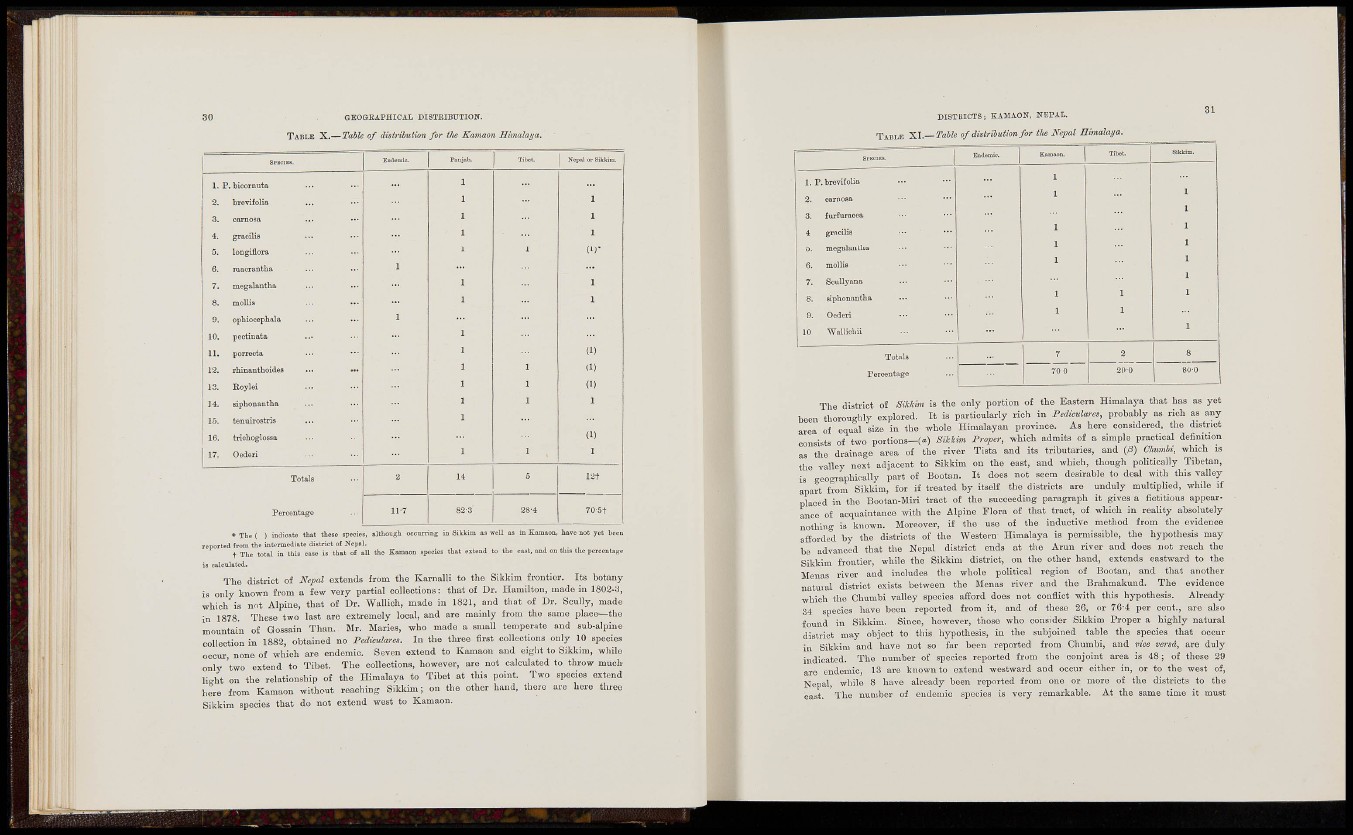
GEOGEAPHICAL DISTEIBUTIOIÍ,
TABLE X.—Tabh of disiribution for the Kaviaon Himalaz/a.
Srscies. Endenjis. Panjnb. Tibet. Nopal or SikJdra.
1. P. bioornuta 1
2. trevifolia 1 1
3. carnosa 1 1
4. gracilis 1 1
6. longiflora 1 1 (1)-
6. laacrantha 1
7. megalantlia 1 1
8. moUis 1 1
9. opbiocephala 1
10. peetinata 1
11. porreeta 1 (1)
12. rhinanthoides 1 1 (1)
13. Eoylei 1 1 (I)
14. eiphonantha J 1 1
IS. tenuirostris 1
16. trichoglosaa (1)
17. Oederi 1 1 1
Totals
PercGutage
2 14 5 l i t
11-7 82-3 28-4 70-5t
* The ( ) indicate tiiat theae species, althougli occurring in SiliMm as well as in Eomaon, ha^e not yet been
reported from tiie intermediate district of Nepal. . , . ,
+ The total in tiiis case is that of all tiie Kamaon spccies that estcnd to the east, and on this the pcrcentase
is calcnlated.
The district of Sepal extends from the Karnalli to the SIkkim frontier. Its botany
is only known from a few vory partial collections: that of Dr. Hamilton, made in 1802-3,
which is nnt Alpine, that of Dr. Wollich, made in 1821, and tliat of Dr. Scully, made
in 1878. These two last are extremely local, and are mainly from the same place—the
mountain of Gosaain Than. Mr. Maries, who made a .small temperate and sub-alpine
collection in 1882, obtained no Fediculares. In the three first collections only 10 species
oconr, none of which are endemic. Seven extend to Kamaon and eiglit to Sikkim, while
only 'two extend to Tibet. The collections, howeTer, aro not calculated to throw much
light on the relationship of the Himalaya to Tibet at this point. Two species extend
here from Kamaon without reaching Sikkim; on the other band, there are here three
Sikkim species that do not erfend west to Kamaon.
DI3TLLICTSI ZAMAOH. FEPAL.
TABLE XL—Table of distribution for tlie Nepal Himalaya,
2. carnosa
3. furfuracea
4 gracilis
6. megalantlia
6. mollis
7. ScuUyaaa
S. siphonantlia
9. Oederi
10 Wallichii
The district of aiiUm is the only portion of the Eastern Himalaya that has as yet
been thorouAly explored. It is particularly rich in Pediculares, probably as rich as any
area of eqnil size in the whole Himalayan province. As here considered, the district
consists of two portions—(«) Sikkim Proper, which admits of a simple practical definition
as the drainage area of the river Tista and its tributaries, and (ii) CImmU, wliich is
the valley next adjacent to Sikkim on the east, and which, though politically Tibetan,
is ,eo<rraphically part of Bootan. It does not seem desirable to deal with this valley
apart from Sikkim, for if treated by itself the disti-icts are nnduly multipKed, while if
placed in the Bootan-Miri tract of the snccecding paragraph it gives a fictitious appear-
L c e of acquaintance with the Alpine Flora of that tract, of which in reality absolutely
nothing is known. Moreover, if the use of the inductive method from the evidence
afiorded by the districts of the Western Himalaya is permissible, the hypothesis may
be advanced that the Nepal district ends at the Arun river and does not reach the
Sikkim frontier, while the Sikkim district, on the other hand, extends eastward to the
Menas river and includes the whole poUtical region of Bootan, and that another
natural district exists between the Menas river and the Brahmakund. The evidence
which the Chnmbi valley species afford does not conflict with this hypothesis. Already
34 species have been reported from it, and of these 26, or 76-4 per cent., are also
foimd in Sikkim. Since, however, those who consider Sikkim Proper a highly natural
district may object to tliis hypothesis, in the subjoined table the species that occur
in Sikkim and have not so far been reported from Ciiumhi, and wee versa, are duly
indicated. The number of species reported from the conjoint area is 48; of these 29
are endemic, 13 are known to extend westward and occur either in, or to the west of,
Nepal, while 8 have already been reported from ono or more of the districts to the
east. The number of endemic species is very remarkable. At the same time it must